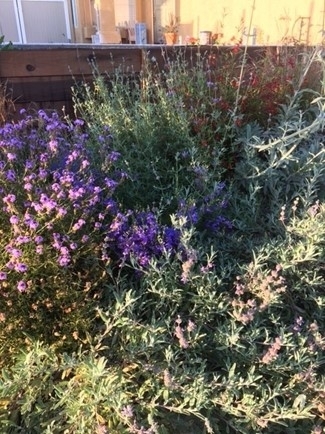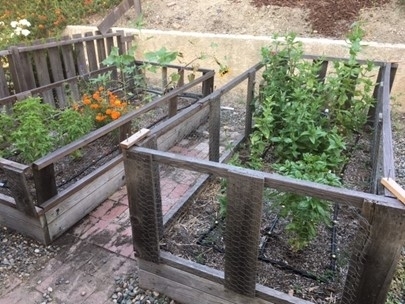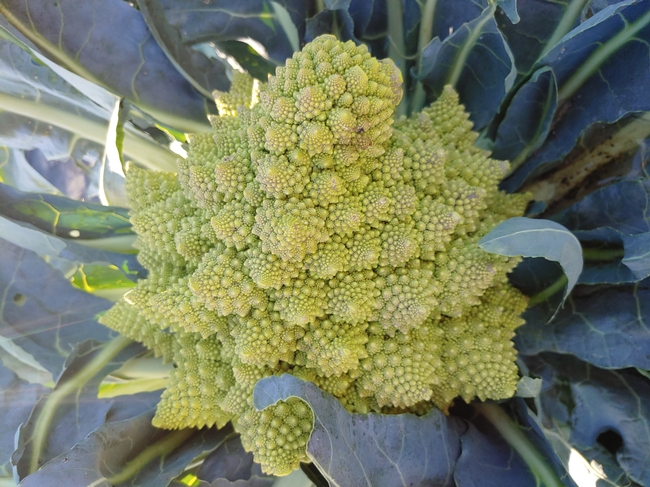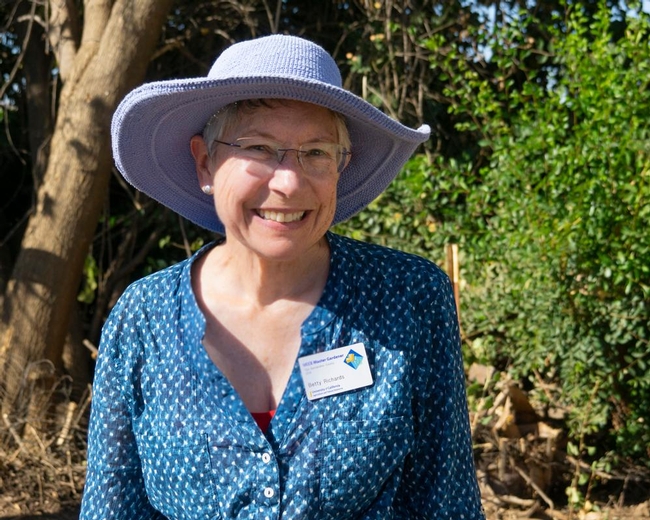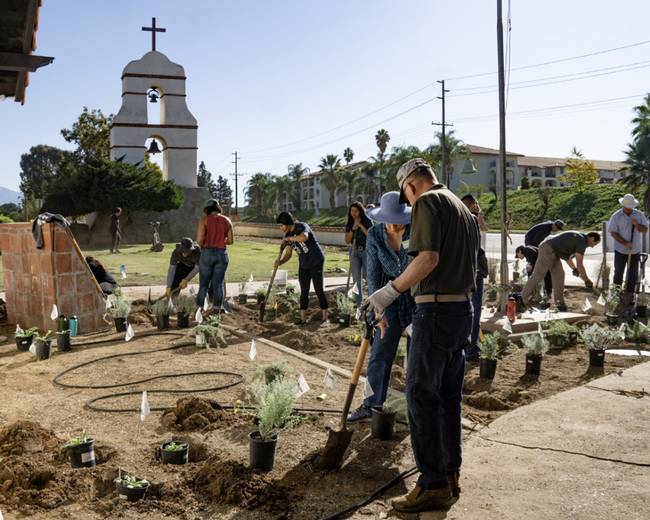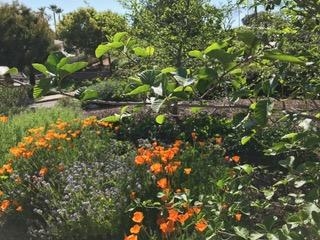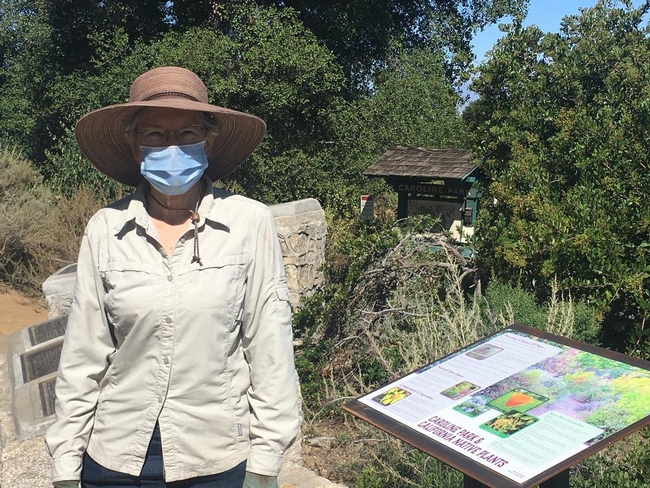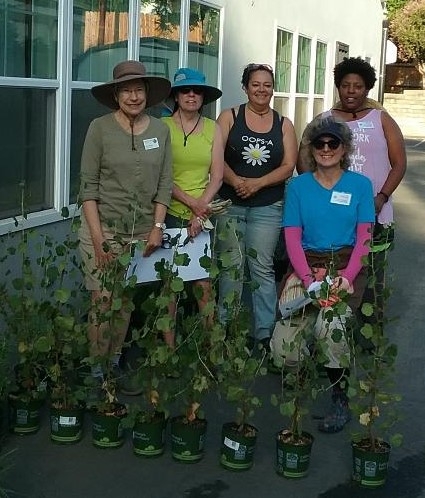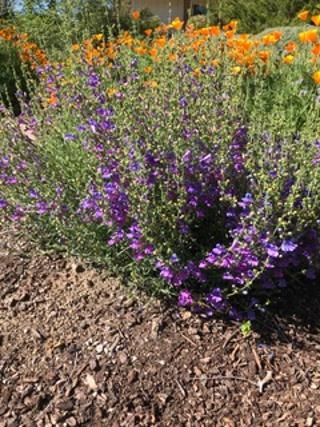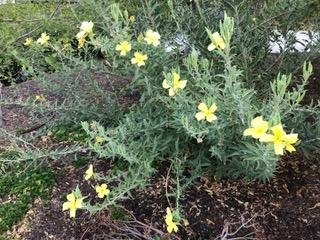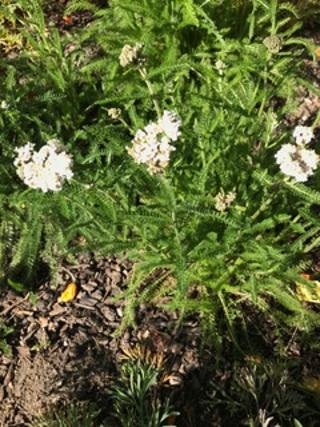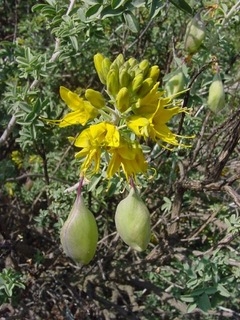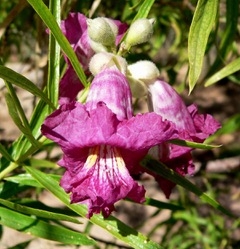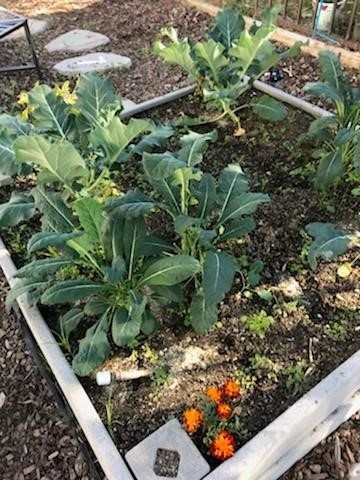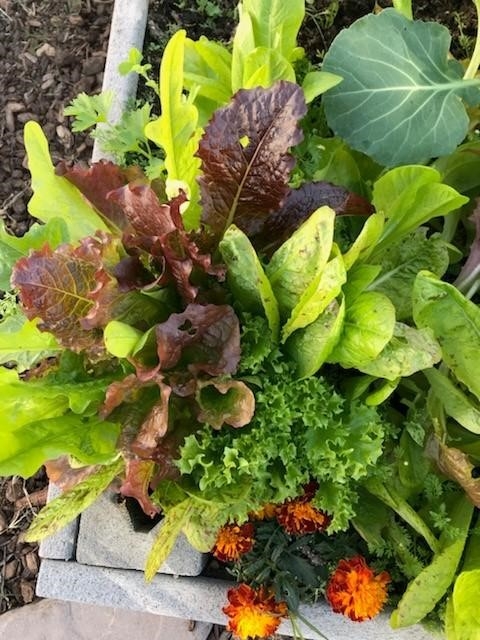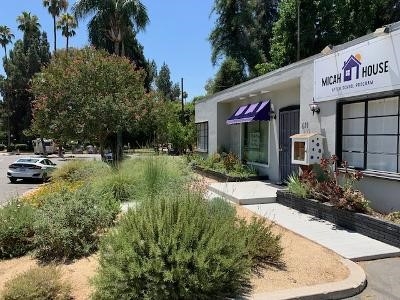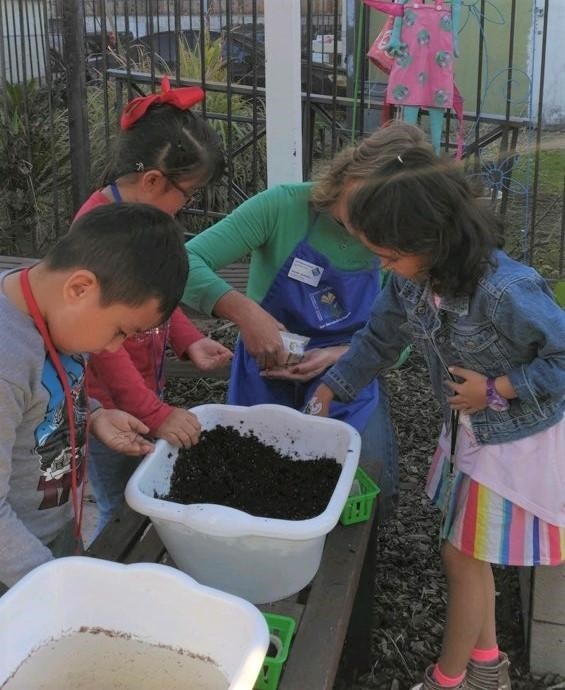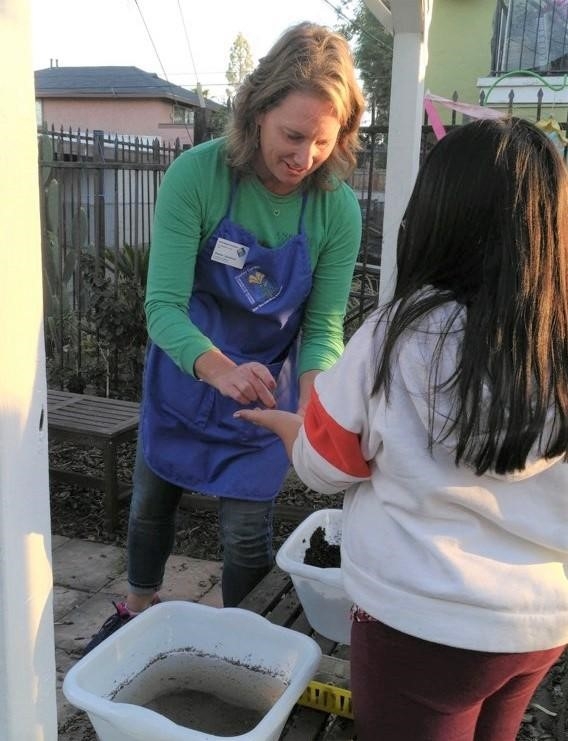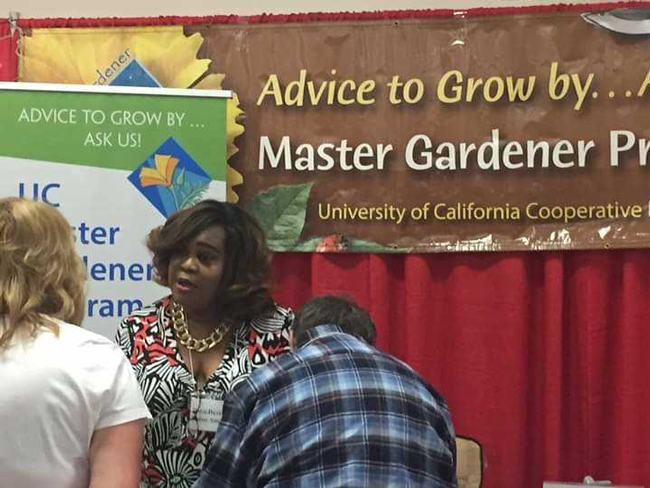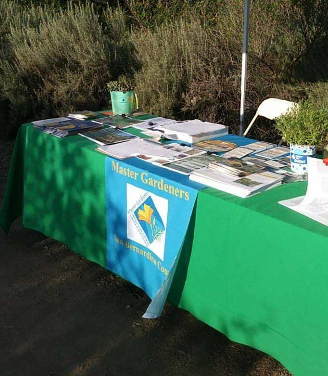- Author: Debbie LeDoux
In today's world, we have too much information, too much pressure, and too much to do. Many people would like to contribute to their community. Still, they cannot find time in their busy schedules to volunteer. When UC San Bernardino County Master Gardener Michael Bains first became a Master Gardener in 2017, he wanted to volunteer. He was unsure how he could find the time while working full-time and raising two young children with his wife.
His love for gardening and passion for the UC Master Gardener program inspired him to find creative ways to manage his time to contribute to the Master Gardener program. He saw a need for volunteers to work on the UC San Bernardino County Master Gardener helpline and thought it would be interesting to learn more about it. Michael realized he could research callers' gardening questions and provide answers on his lunch hour or after hours while home with his family. So, he thought he would give it a try. That one small step evolved into Michael's providing consistent helpline support to the local community for several years.
Michael enjoys interacting with the people who contact the helpline. Everyone he has met through the helpline has been appreciative of the information provided by all the volunteers. He says it is a good feeling knowing that he has helped other gardeners. Callers realize the helpline's value delivering research-based and practical gardening and horticulture answers to their questions. San Bernardino County residents are invited to contact Michael and his fellow helpline colleagues with their gardening questions via telephone (909.387-2182) or email mgsanbern@ucanr.edu. Please leave a message with your name and contact information along with specific information about your gardening or landscaping question(s).
Michael learned through the UC Master Gardener program how easy gardening can be. In the class on fruit trees, he learned about the variety of fruit trees grown in San Bernardino and that many trees can be espaliered. Michael had a property section at his house where he wanted to create more privacy from his neighbors. He decided that a couple of espaliered apple trees might multi-task as a privacy screen and provide fruit for his family's consumption. Michael says the process for espaliering trees is not complicated and that anyone can do it. His first step in the process was to embed three posts in the ground 8 feet apart. In step 2, he ran a metal wire across the posts at 18 inches and 36 inches above the ground. Step 3, he planted the apple trees between the posts. Step 4, he attached individual branches of each of the trees to the nearest wire. As each tree branch grows, he continues the process of connecting limbs to the closest wire. Michael enjoyed his first experience with espaliering trees so much that he is espaliering some peach and nectarine trees in his front yard. What Michael likes best about the UC Master Gardener program are the people he meets.
He says that gardeners are some of the nicest people he has ever met and that he has “never met a grumpy gardener.” UC Master Gardeners are just a further example of that! If you are interested in becoming a UC Master Gardener, Michael encourages you “to go for it!” The 3-month research-based UC Master Gardening training takes time; however, it is rewarding. You will learn a lot about home horticulture, pest management, and sustainable landscape practices. (While the current class is full, if you are interested in next year's class, please leave your contact information with the MG helpline to receive information when the application process opens again).
Michael developed an interest in gardening when he took a vegetable class in 2015 at the Loma Linda Library. He learned a lot about vegetables and realized that he enjoyed gardening. At the time, he thought, "Hey, I can do this!" Taking the vegetable class helped him grow a vegetable garden in his side yard. His gardening interests have taken off from there.
Michael's Native Plants Garden
In learning about sustainable gardening and the importance of native and well-adapted non-native plants, Michael and his wife developed a strong desire to remove the lawn at their home and replace it with native plants. In 2017 he took out the family's front yard. I have heard many different approaches to taking out a lawn, from simple steps to more labor-intensive methods. Michael was so motivated to replace his yard with native plants that he removed it the old-fashioned way with a shovel and hours of backbreaking labor. Michael has been a member for several years of the Rancho Santa Ana Botanic Garden (RSABG), now known as the California Botanic Garden in Claremont. He has always enjoyed and appreciated native plants but thinks people sometimes do not fully appreciate them. They see native plants in their natural, wild habitat during the hot summer months when their beauty might not be at their peak. Michael decided he wanted to demonstrate that native plants can be an attractive addition to gardens in all seasons with some TLC, and they are easy to grow. Michael did not need to use any soil amendments; “you just plop them in the ground” and let them grow. Michael posted an excellent article on the UC ANR website about using native plants https://ucanr.edu/blogs/blogcore/postdetail.cfm?postnum=24031.
He replaced one side of the yard with an olive tree and under plantings. He created a courtyard with native plants on the other side of the yard leading to the front door. Michael says it takes work (removal of whatever was there, adding irrigation, mulching) to start a native plant garden. Still, it is a good feeling of accomplishment! In April 2017, Michael decided to transition one of his raised bed vegetable gardens to a cut flower garden.
Michael's Cut Flower Garden
His decision to transition was because he fought a losing a battle with the “Squirrel Hoards of Chino Hills.” Michael found the transition easy because vegetable gardens and cut flower gardens require the same things - rich, loose soil, fertilizer, and regular watering. Be sure to read Michael's helpful article on the transition he made https://ucanr.edu/blogs/blogcore/postdetail.cfm?postnum=25189.
Michael likes to use drip irrigation systems in his garden. He has converted nearly all his yard to it. Michael has practical advice to anyone interested in converting to a drip irrigation system. Use a drip line and prepare a grid system to cover the whole bed. Don't use a drip line that you will need to punch into and then add emitters. As the plants grow, you will need to move the individual emitters further from the plant. You will also have to go to the trouble of adding more emitters when you plant a new plant. They also seem to break more often. Michael enjoys container gardening as well as in-ground gardening. He likes to grow plants that do not do well in Chino Hills' heavy clay soil in containers. He has dahlias growing in containers this year with an underplanting of pansies, basil, mint, parsley, tea roses, and some clipped boxwood. Michael has a tip for gardeners who are interested in container gardening. The rabbits and squirrels eat those plants too, so be prepared to keep the critters out. They can reach higher than you think.
The UC San Bernardino County Master Gardeners are thankful for Michel's dedication to the helpline. He has extensive practical gardening knowledge that he shares with anyone who contacts the helpline. He also shows us how we can manage our time effectively to fit volunteer activities into our busy lives!
- Author: Margaret J O'Neill
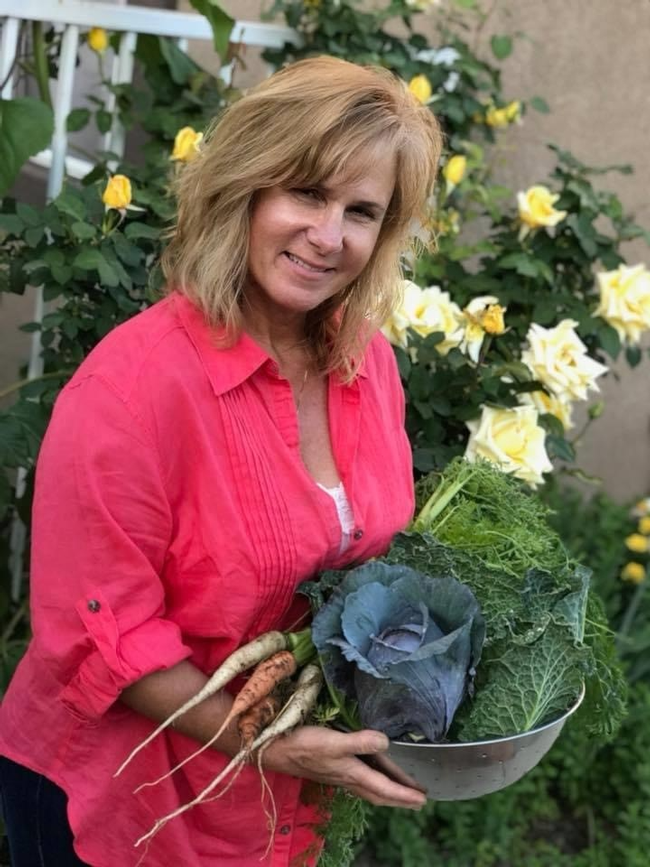
With these cooler temperatures and shorter days come cool season gardens. Cool season gardens that grow in the fall and winter are sometimes less celebrated than spring and summer (warm season) gardens, but they can be just as fun and yield more nutritious produce than our warm season garden.
Our warm season gardens yield lots of delicious and wonderful fruits (the part of the plant that has the seeds), and they are yummy for sure! Our cool season gardens give us lots of edible leaves and stems and roots packed full of vitamins and minerals that we don't get from our warm season garden. So, if you are skipping your cool season garden and waiting until next spring, you are missing the most nutritious gardening time of the year! Here are some tips for success for your cool season garden, and don't forget we offer lots of free classes online (http://mgsb.ucanr.edu/) each month and our helpline is just a call or email away!
- Select the right location: Most veggies take at least 6 hours of sunlight, so check your spot and make sure they will get enough light. The sun starts to go south in the winter, so the shadows in your yard and on your patio change. Track the sunlight for a day in the area you want to plant, watch for shadows and see if there are trees or fences on the south side that may cast a shadow later in the year, in the middle of winter. Veggies can thrive planted directly in the soil, in raised beds or in pots so you do not need a lot of space to have a cool season veggie garden. Don't forget as you are planning your spot to think about vertebrate pests like gophers….they love your cool season veggies just as much as you do, and are often very active in the spring and fall. Plan ahead and contact our Master Gardener helpline if you have questions on how to protect your crops! Remember that having accessible water close by is also very important unless you have the time and energy to carry buckets full of water back and forth since you can't always count on Mother Nature.
- Deciding what to plant: Plant a rainbow of color, plant what you and your family like to eat, and try a few things that you and your family don't like to eat since home grown veggies have a completely different taste than veggies from the store! They are often sweeter and more flavorful, so if you don't like it but have never tried it home grown then give it a try. Some cool season veggies are: carrots, beets, broccoli, brussels sprouts, radishes, cauliflower, celery, chives, endive, fava beans, kale, leeks, lettuce, onions, parsley, parsnips, peas, spinach, swiss chard and turnips, just to name a few! Herbs also grown year-round. Fall is a great time to start cilantro along with many other herbs to compliment your edible vegetable garden. If you live in the mountains you have a really short cool season veggie window, so be sure to select varieties that are “early ripening” so you can get them harvested before the really cold weather comes.
- Preparing your soil: When it comes to growing veggies, you want to have nice and fluffy soil. Many root veggies like a soft soil so they can grow correctly, and the rest of the veggies don't mind it either! Amend your soil with compost to help improve drainage in heavy soils and improve water retention in sandy soils. Add at least two inches of compost and dig it in to the first 6” or so of soil. Don' forget that while compost is great and adds lots of wonderful microorganisms to the mix, it is pretty low on nutrients, so it's not a substitute for fertilizer!
- Fertilizer: Veggies in general are heavy feeders and should be fed regularly to produce a good crop. Generally it's a good idea to fertilize the soil when you plant them. (This isn't usually true of fruit trees, flowers or ornamental landscape plants though so don't do that to all of your plants: more is not always better). Then fertilize approximately every 4 to 6 weeks, depending on your soil and the crop you have planted. A good rule of thumb for growing veggies in pots is to fertilize them half as much twice as often since they are more susceptible to burning than in-ground plants.
- Mulch…mulch and more mulch!! Adding a mulch layer on top of the soil around your garden plants is so important during the summer to retain soil moisture, conserve water, and keep soil temperature cool but it is also important in the cool season, too. Mulch helps keep weeds down when you add at least 3 to 4” and will help keep the soil temperature from getting too cold in the cooler parts of the year. Be sure to keep your mulch at least 6 inches away from the trunks of your trees and away from the stems of your veggies by at least an inch or two. Don't forget if you are going to much and you want weed control that you need to apply a thick layer (3 to 4”). A thin layer can actually encourage weed seed germination. Mulch is not just for plants in the ground either! It can be used in pots as well and has all the same benefits. Just be sure if you have a nice layer of mulch on the ground or in your pots to keep in mind the type of fertilizer you are using. A granular or pellet fertilizer should be applied to the surface of the soil, a liquid fertilizer can be applied over the mulch as long as it is watered in well. When in doubt, pull the mulch back, or call our helpline and we can help you decide how to best apply your fertilizer.
- Watering: Water is just as important to cool season crops as it is to warm season crops, especially since many of the cool season crops we enjoy are water-filled leaves. Though it is just as important, there are a few different things to think about. The humidity is often higher in the winter, so you need to keep moisture off leaves to prevent the spread of pathogens like molds and mildews. This can be done by using drip irrigation systems, or carefully hand watering, and by watering in the morning to prevent moisture from sitting on the leaves of your plants for too long. You also need to think about how hot it is and how much rain we have had, so it is a dynamic situation! Not sure if you need to water? When in doubt, stick your finger in the soil or dig down a bit for deeper rooting veggies and see if the soil is wet. You can always contact our Master Gardener helpline if you have watering questions or concerns.
- Thinking of seed saving? That's great!! There are lots of reasons to save seeds, from saving money, to creatinglocally grown variety, to preserving special or favorite varieties of veggies, and we are here to help! We offer monthly seed saving classes to teach you everything you need to know from the basics to advanced plant breeding techniques. Many cool season veggies cross breed easily so you must plan a little when you are seed saving. Tune into our “Planning your Cool Season Seed Garden” class to learn more….and if that sounds intimidating, don't worry! There are many cool season veggies that are easy to seed save from, like lettuce, radishes, and peas.
- Don't forget about our bugs! The good ones and the not so good for us ones alike (I hate to use the term “bad bugs,” since they are just doing their thing, even if we don't like it!)! There are many cool season (fall and winter) flowers that will do well and provide habitat and food sources for our beneficial insects that help us keep the bugs we don't want in check in our gardens. Don't forget to stop and properly identify your problem before you spray for “pests” as well! Ask yourself “is this pest going to damage my crops? Is it from an actual insect or disease or is it more likely due to watering issue or a change in the weather? Most garden problems are not from insects or diseases. Always remember to use cultural management practices and avoid chemical pesticides in your home garden. Visit our UC ANR Integrated Pest Management (IPM) site to learn more about how to identify and handle your problems: http://ipm.ucanr.edu/. You can search by pest or by plant and they have lots of great photos. Some pests might look “bad” but will cause little damage, and might actually be beneficial for the environment, so investigate before you treat. That helps reduce pollution, saves you money and helps keep your home ecosystem balanced and healthy. Lastly, the pest that caused the damage may be long gone, making proper identification of pests and abiotic (non-living) disorders key!
- Fruit trees? This a good time to be thinking about planting new deciduous fruit trees such as low-chill apples, plums, pears, and cherries since bare-root specimens are best planted in late December to early February. (Citrus and avocados are best planted in spring or fall.) There are many varieties of deciduous fruit to choose from based on the number of chill hours they need and how many chill hours your location has. Check out this website to find information on chill hours for your area: http://fruitsandnuts.ucdavis.edu/Weather_Services/chilling_accumulation_models/. You can also choose varieties that ripen successively throughout the year so you can extend your harvest season and you can look for varieties that do well in your specific soil conditions and climate.
- Last, but not least? Natives! Fall is the time to get your native plants and seeds in the ground! This is the time of year they would start coming up naturally and when planted in the fall they will have a much better success rate next summer!
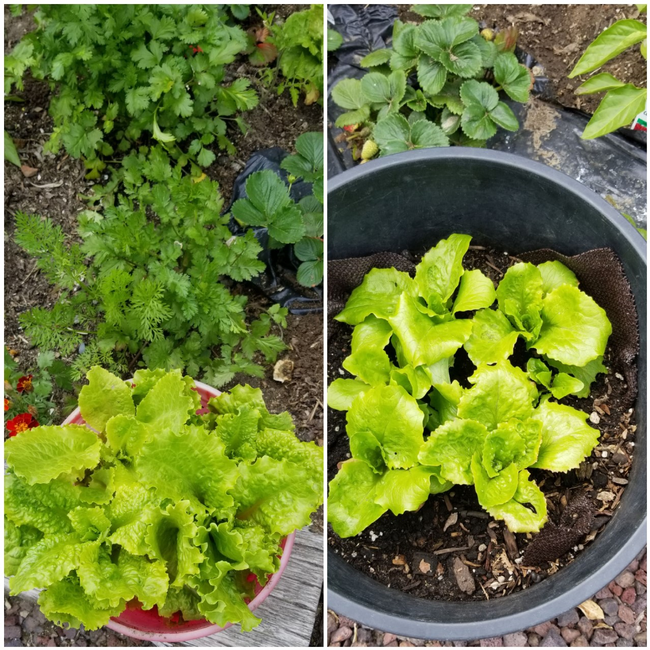
These are the basics you need to think of when planning your cool season veggie garden, and with a little bit of thought and planning, it can be just as delicious, colorful and rewarding as your warm season garden! We are always here to support you through your journey with our monthly free classes, our online “Ask a Master Gardener” time, and our helpline, which is just a call or email away! We will answer your questions and give you moral support when you have challenges. Let us be your cheerleaders and champion and guide you to create the best cool season vegetable garden ever…and don't worry, mistakes will be made….failures will occur…but just like in life, that is how we learn and grow😊
- Author: Debbie LeDoux
I recently enjoyed taking a “virtual garden walk” with UCCE San Bernardino County Master Gardener Betty Richards (class of 2016) while chatting on a Zoom call with her.
I came away from our meeting with the distinct impression that the gardening world is a better place with Betty in it. She has always had a deep interest in our environment and what individuals can do to protect it and make it a better place to thrive.
With increased awareness of the importance of native plants to birds, bees, butterflies, and our environment, Betty has become more active in promoting California native plants in home gardens. With her science background (she is a retired physician), coupled with a passion for sustainable gardening and protecting the environment, she has a winning combination for success.
Betty not only believes in the UC Master Gardener mission of sustainable gardening but exhibits her beliefs through her actions and participation in numerous volunteer activities. Volunteering for various Master Gardener activities has allowed Betty to meet people and find out about other projects that interest her. She has successfully and tirelessly led many Master Gardener projects.
Betty and fellow Master Gardeners designed the native plants demonstration garden at the historic Asistencia on Barton Road in West Redlands. The Asistencia was acquired by the Redlands Conservancy to teach about the history of Redlands, the history of native Californians, and as a place to demonstrate the importance of incorporating native plants in neighborhood landscapes. In November 2019, Betty worked with a large group of volunteers from the UC Master Gardeners and the local community to plant the demonstration garden. She continues to be involved in the Asistencia project by educating the staff about caring for the native plants. She is currently working with fellow Master Gardeners Heather Ross and Heather Nichol on designing and implementing the main front garden area and a cactus/succulent garden at the Asistencia. We look forward to seeing the changes that Betty and the UC Master Gardeners team and other community volunteers make to the Asistencia gardens.
Betty is the main organizer of the UCCE San Bernardino County Master Gardeners' presence at the Redlands Farmers' Market. She coordinates volunteers, makes sure the Master Gardener information table is set up, and that printed gardening materials are available to give out to people who stop by. Betty says it is fun to talk to the folks who visit. Working at the Farmers' Market is an excellent opportunity to get to know fellow master gardeners working at the table and trade gardening tips. Betty is looking forward to COVID restrictions being lifted so the Master Gardeners can get back to providing research-based answers to gardening questions!
In early 2020, Betty started organizing a quarterly series of talks by Master Gardeners at the Redlands Community Center on Lugonia Avenue. This was begun, as an educational activity for gardeners from the city's community gardens and attracted many community members. Betty hopes to continue these well-attended talks when COVID restrictions are lifted and the community center reopens.
Last spring, UCCE San Bernardino County Master Gardeners Betty Richards, Linda Richards (no relation to Betty), and Brenda Spoelstra got together with the California Native Plant Society's local chapter and planned a tour of their local native gardens. Each of the three yards was in different lawn replacement stages with low water-use plants – Brenda Spoelstra's new drought-tolerant space, Betty Richards' maturing (3-5 years) garden, and Linda Richards' mature garden. When the COVID 19 pandemic made the tour impossible, they made virtual tours of the gardens and posted them online https://ifnaturecouldtalk.com/youre-invited-to-virtually-visit-three-california-gardens.
Gardens such as the three featured in the native plants video take time and care. The transition of Betty's lawn to a native plants garden has evolved over the past 3-5 years, and continues to evolve. In 2015, she decided she would begin the process of transitioning the water-thirsty lawn at her home to California natives and other low water use plants. She started the process by learning all she could about which native plants to grow in her garden. She took a class on how to grow native plants at the Rancho Santa Ana Botanical Garden (now California Botanical Garden) in Claremont, California. The 86 acres garden is a non-profit organization dedicated to California native plants. Events and classes are offered throughout the year.
Betty also researched native plants on the California Native Plant Society Calscape website https://calscape.org/. She recommends the website to anyone interested in making the transition to a native plants garden. It is an excellent source of information about which plants are native to any location in the state. It helps people figure out which plants to use, where to buy the plants and how to grow them.
When Betty started to work on the transition, she decided to leave a group of existing White Alder trees that thrived in the well-watered lawn space. She added an extension to a pre-existing drip irrigation line to continue to give the trees the irrigation they needed. After putting in a path of decomposed granite she planted a group of three desert willows and added other low-water-requiring native shrubs and perennials. Every year she adds a few more plants and throws out some wildflower seeds before the first winter rains.
She has recently added a birdbath to encourage birds to stop by and visit the garden. Over the years, she has seen an increase in native bees, butterflies, and birds. Her water bill has even decreased significantly! The evolution of Betty's garden continues with plans to add keystone species of plants to the landscape. Keystone plants for our local area such as live oaks, ceanothus, coyote brush, and black sage are especially important in supporting a diversity of life.
For the past year, Betty has been working as a volunteer at Caroline Park in Redlands. The City of Redlands 16+ acres park is planted with California native plants. On Tuesday mornings, a small, dedicated crew works to remove invasive non-native plants, prune, and maintain the plants and trails. If you have the opportunity, take a walk in Caroline Park to see which California native plants are blooming. The park is primarily a great example of the dwindling Coastal Sage, although it also showcases several habitats, including woodlands and various chaparral plants. Betty would love readers to view the beautifully produced video she made to spread the word about this local native plants gem https://www.youtube.com/watch?v=v7FQAb0AuOI. She hopes that the video will inspire people to plant some natives in their home landscape. I have viewed the video several times and am always touched by the “visual poem” created by Betty to the park.
In the summer of 2018, Betty and fellow UC Master Gardeners Anita Matlock and Trisha Fitzgerald participated in transforming a grassy area in the front yard of Micah House into a lovely drought-tolerant garden. Micah House in North Redlands is an after-school educational program for children and youth from 1st through 12th grades. It provides homework help, tutoring, literacy education and character-building themes and extracurricular activities, including gardening, art, music, and bike restoration.
Master Gardeners removed the existing lawns and replaced them with drought-tolerant plants watered by a new drip irrigation system. They partnered with Micah House staff, families of their after-school program, and the community. On planting the day, they worked with volunteers from Trinity Church and children and staff from the Micah House program to put the finishing touches on the water-wise garden. The project was made possible through a grant from the Inland Empire Resource Conservation District (IERCD). (Betty also serves as an advisory committee member for the IERCD/UCCE Master Gardener partnership which helps UCCE programs reach over 35,000 county residents each year.)
Betty has always been interested in outdoor activities such as gardening, birding, hiking, and camping. She has done some vegetable gardening in raised beds and some planting of “this and that about the yard.” So, when she heard about the UC Master Gardener program through a friend who was applying to Riverside County's class, she applied to the UC San Bernardino County course. The UCCE San Bernardino County Master Gardeners are thankful that Betty took that step and joined.
Betty says that what she likes best about the Master Gardener program is meeting new friends who love to garden and share their gardening knowledge. She encourages anyone interested in becoming a Master gardener to apply. “There are many opportunities to try different gardening areas. It doesn't matter whether you are a very experienced gardener, an enthusiastic beginner, an introvert, an extrovert, no matter your age or abilities. You can start a community garden, present at gardening events, or even help provide research-based information to people calling in on the Master Gardener Helpline. There are many opportunities to utilize your current skills and strengths and develop new ones and develop confidence.” Working on the Micah House project gave Betty the confidence to jump into designing the Asistencia project.
Through the Master Gardener program, Betty has become more aware of the many ways people in our communities are working toward a sustainable future for our region and our planet.
Here is some "food for thought" that I came away with from my time spent chatting with Betty. Birds are an excellent indicator of the health of the environment. 29% of the population of birds in the United States and Canada have disappeared since the 1970s. Many songbirds require insects to feed to their young. Caterpillars are especially important to birds. Betty is a natural teacher, illustrating concepts through storytelling that non-gardeners and gardeners can understand. “Think of a caterpillar as a little sausage full of good nutrition for a baby bird. Most caterpillars (not just the Monarch butterfly caterpillars) require particular native plants. As we lose our wild areas to development, we are losing our birds and butterflies. This is because the ornamental plants we have used in our gardens for so many years do very little to support them. We can do something about this by planting native plants and avoiding the use of pesticides. We don't have to have 100 % of natives to make a difference."
GALLERY OF SOME OF THE NATIVE PLANTS IN BETTY'S GARDEN.
- Author: Brenda Spoelstra
I became a University of California Cooperative Extension (UCCE) Master Gardener in San Bernardino County in January of 2019. I had learned about it from a friend who is an instructor with the UCCE Master Food Preserver program. She knew I liked gardening and suggested I look into it to see if it was something I would like to do. At the time I was working for a City Parks and Recreation Department in Planning and Design and my interest was increasing public open spaces and parks and gardens, knowing how essential they are to a healthy lifestyle. In another way, I was looking for an opportunity to get involved in the community. My interest in gardening and garden design just seemed like a natural fit for the UCCE Master Gardener program.
Within the UCCE Master Gardener program, I have volunteered in the San Bernardino School District (SBUSD), informational tables at farmer's markets, and more recently, with a non-profit after school program in Redlands called Micah House. There are two locations but the Micah House program on Oxford Street has been my main connection in the community, working with the mothers of after-school students on their vegetable boxes.
(The UCCE Master Gardener program would like to express gratitude to Micah House Executive Director Alison Anderson and the Chapel Street Micah House team for opening their doors to allow us to offer our 18-week training class there. In turn, Master Gardeners partnered with Micah House staff, families of their after-school program, and the community at large to transform a grassy area in their front yard into a lovely drought-tolerant garden through a grant from the Inland Empire Resource Conservation District.)
In one of my first UCCE Master Gardener activities with the SBUSD, I quickly became aware that it would be imperative to know Spanish well if I wanted to contribute to the UCCE Master Gardener mission to, "develop and extend practical research-based information in agriculture and natural resource to the residents and workforce of San Bernardino County." The US census states that 54% of San Bernardino County is Hispanic, and that 37% of the population speaks Spanish as their first language.
Thus, the story of how I needed to re-learn Spanish led to becoming the on-site UCCE Master Gardener at Micah House on Oxford Street. It began when I reached out to an extended family member who previously taught an immersive Spanish program and is the program director at Micah House on Oxford Street, for Spanish tutoring. After a couple of sessions, she asked if I might be interested in leading some gardening workshops in their vegetable beds started by the previous program director. Well of course! One hiccup. The mothers I would be instructing in gardening speak only Spanish and I want this to be inspiring, not complicated.
In the fall of 2019, with interpretation help from the program director, we set off together in planning the cool season vegetable garden with four mothers of children in the program. We were able to discuss the appropriate cool season vegetables and they selected the desired plants to grow over the winter. None had grown any of their own vegetables but were superb at gardening techniques such as weeding and planting. Much of gardening workshops can be a physical demonstration and then accomplished by the attendees, and I'm thankful for that because at this point my Spanish is still not up to a working standard!
With Spring coming, the program director had an idea how to include the children. We had an activity for them to plant seeds in recycled egg cartons, to be grown indoors as starts for the Spring garden. Again, the mothers were in the lead with selecting the warm season vegetable types and decided on a salsa garden.
With the help of the seed supply in the UCCE Master Gardener office, the kids were able to plant onion and jalapeno peppers. The mothers decided what to plant, install, regularly maintain. Harvest from the vegetable boxes are generously shared with their neighbors. Even with a few Spanish words, my sub-par communication skills seemed to go a long way with building rapport within the community and the workshops seem to be exciting for the kids and the vegetables are growing well! Fast forward to January, they are now harvesting cilantro, radish, lettuce, kale, and soon beets, carrots, and broccoli.
I like the personal benefits of gardening, doing something outdoors while getting a little exercise. Also, the learning and the organizational skills built on from one season to the next as you learn more about how plants behave in changing seasons. Watching plants form and develop over time makes it an activity of patience, as well, along with the maintenance lessons and mistakes. Before becoming a UCCE Master Gardener, I had experience in developing my backyard from a dead lawn to trees, shrubs, and flower garden (along with vegetable patch gardening). I believe the most outstanding thing I learned is the number of people volunteering in the community and the free resources UCCE Master Gardeners provide. I had not heard of the program up until then, and I think the program has many more ways to develop and transform in the coming years.
What I like best about the UCCE Master Gardeners program is the access to the science-based peer reviewed information regarding growing, pest management, and resources on plants and their requirements. It gives more confidence to the advice and recommendations I give in the community, which supports the work, rather than just relying on someone's personal experience with gardening. I think the first thing I would ask people interested in becoming a UCCE Master Gardener is whether they have a personality that likes to engage with the community. You can't stay sheltered away from the public while being a UCCE Master Gardener and you can't just have an interest in more information to be an arm-chair expert without experience. We test our knowledge in the community with questions they have or with activities which go along with instruction.
You may not have a natural desire for teaching, but you will need to have some interest in passing along knowledge with an open mind and appreciation for varying levels of experience in others. I tell people just because I have the UCCE Master Gardener badge does not make me a master of gardening -- it's the process of mastering, which never ends. I have a list of community service, both domestic and international. I've been involved with a City's Arts commission, 5k founder and organizer, an overseas director's assistant on a construction project, installed California Native gardens, community garden volunteering, and various past volunteer work with churches and work.
The purpose of this brief article is, even though you may think a little isn't enough, your efforts extended to the community can go a long way and grow into something you may not have planned. Stay open to opportunities and activities; you just never know where 'yes' will lead you.
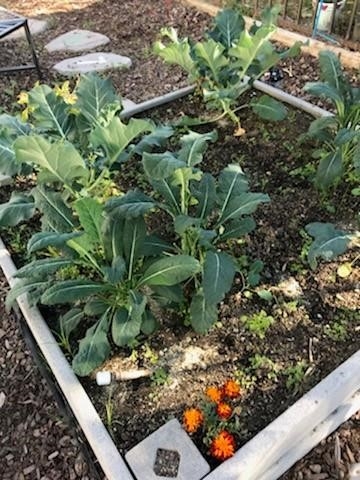
- Author: Margaret J O'Neill
Calling all Gardeners! Class is open!!
Have you been thinking about taking the Master Gardener training class but aren't sure if it's for you? Maybe this blog 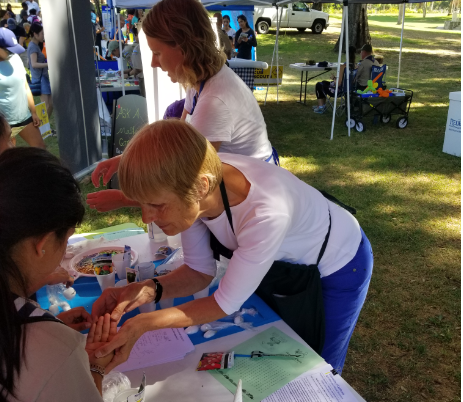
Who would make a good Master Gardener?
-You!!! Seriously….this program succeeds because of diversity…….of mindsets, geographical location, educational background, culture, ethnicity, gardening experience, and perspectives. If you are reading this blog, you likely already have an interest in plants and could be a great Master Gardener!!
-People who want to help empower their neighbors, their community, and the residents of San Bernardino County by teaching them how to grow edible and landscape plants successfully. Our volunteers work throughout the county to teach people about three main topics: Growing Food, Sustainable Landscaping and Healthy Lifestyles and Better Living Through Gardening. Within those topics we can teach a lot of things, but the core of our program is sharing research-based information with the public so they can learn how to grow some of their own food and create their own gardens, green spaces, pollinator gardens and more, all while saving resources and protecting the environment and building community.
-People who love love love gardening! If you are passionate about gardening, you are halfway there!! Many of our Master Gardeners are shy at first about working information tables or giving presentations but they all say that when they focus on their love of gardening instead of thinking about “knowing everything” they find sharing with the public fun and rewarding (hint- we don't know everything, but we have a whole team of fellow Master Gardeners to help us, and in the class we learn how to find credible information to share on all kinds of topics!). There are also behind the scenes volunteer opportunities for those who are really not comfortable with being in front of people. We work to accommodate all comfort levels when it comes to sharing the knowledge you learn with the public.
-Community leaders who are looking to improve outcomes in their area. The Master Gardener program works with many community leaders to help be part of a positive vision/outcome for their neighborhood and what better way to know how Master Gardeners can help than to learn about the program firsthand. While there is a volunteer requirement as part of being a Master Gardener, there are a lot of way to get your hours in and we work with each individual to see what would work best for them.
- A wide variety of gardening topics like: sustainable landscaping, mulching, soil preparation and composting; growing food; plant pathology; plant propagation; integrated pest management; fruit tree care; how to properly water plants and what an ET rate is; all about irrigation equipment and use; what ACP, GSOB, ISHB are (and you will learn what those things stand for too!); all about beneficial insects, what they are and how to create habitats that can support them year round……just to name a few things this course will cover.
-How and where to volunteer within our program so you can start sharing your knowledge with the public and how to start projects in your community with the support of our Master Gardener committee chairs.
-We can spend a life time learning about plants and there will always be new things to learn and breakthroughs….so one of the things we really focus on is: how to research, where to go, how to determine if resources are credible, and what kind of questions to ask when you are looking things up
Besides learning all about plants, what will you do as a Master Gardener and what do we expect of you?
-Examples of our outreach are: Giving or supporting online presentations (and in person when it is safe to do so); work our helpline (by receiving training and answering questions by email and phone); work with school and community gardens; work on citizen science projects; volunteer to support our seed library; when it is safe to go back to in person activities we work at info tables and events sharing info with the public on our three areas of focus (growing food, sustainable landscaping and healthy/better living through gardening) and do demonstrations for the public on gardening techniques, irrigation set up and planting and more.
We just ask that you join our class with an open mind and heart and that you be prepared to take what you learn and share that information back with your community and the public (through the projects that we have going on, or projects that you work with us to develop). Our goal is to get all (and I mean all) of San Bernardino County residents gardening, whether that be in a community garden, a window sill garden, their back yard, or in pots on their patio…..and that goal takes a lot of passionate people!! All of the information we share with the public is research-based peer reviewed information and that's what you will learn about in the 18 week training class. In addition to the classes you take we will link you with experts and hundreds of research based publications so you will be well prepared to answer questions and direct people to resources (remember that we don't know everything, we just know who to ask and where to look to find credible, research based information).
Volunteering looks different for everyone and we understand that all of our UCCE Master Gardeners are sharing their time and passions with us in addition to living full lives themselves. So, you may volunteer on a regular basis with projects near home, or work a little bit each month, or you may be part of the dozens of Master Gardeners who help us with our spring outreach. Some volunteers spend many hours each month and get hundreds of hours each year and some volunteers are only able to get the 50 hours they need in the first 18 months (and the 25 hours needed each year after that). Both types of volunteers are so appreciated, and needed to keep our program running.
So, if you think that you might have time to give back to your community and want to improve the lives of people in SanBernardino County please consider applying to the Master Gardener. Becoming a Master Gardener is a lifelong journey that starts with taking the course as the foundation (or roots of a tree?) that will grow as you learn and start to work with and develop projects that you are passionate about. Please note that you are required to attend ar live information sessions offered via Zoom before your application will be accepted. August information sessions are on August 8 (2:30-3:30pm) and August 19 (9-10am). They will provide you an opportunity to ask your questions and find out more about the Master Gardener program. Register for a session on our website: http://mgsb.ucanr.edu/. We look forward to having you join our team as a fellow Master Gardener, or as a participant in our free upcoming classes for the gardening public listed in this newsletter!


